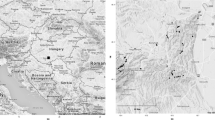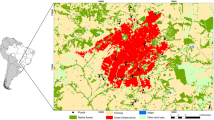Abstract
Spatial and environmental processes influence species composition at distinct scales. Previous studies suggested that the distribution of larval anurans at the landscape-scale is influenced by environmental gradients related to adult breeding site selection, such as pond canopy cover, but not by water chemistry. However, the combined effects of spatial, pond morphology, and water chemistry variables on metacommunity structure of larval anurans have not been analyzed yet. We used a partial redundancy analysis with variation partitioning to analyze the relative influence of pond morphology (e.g., depth, area, and aquatic vegetation), water chemistry, and spatial variables on a tadpole metacommunity from southeastern Brazil. We predict that pond morphology and canopy cover will influence the metacommunity at broad spatial scales, while water chemistry would play a larger role at finer scales. We found that broad-scale spatial patterns of pond canopy cover and pond morphology strongly influenced metacommunity structure, with water chemistry being not significant. Additionally, species composition was spatially autocorrelated at short distances. We suggest that the reproductive behavior of adult anurans is driving tadpole metacommunity dynamics, since pond morphology, but not water chemistry affects breeding site selection by adults. Our results contribute to the understanding of amphibian species diversity in tropical wetlands.



Similar content being viewed by others
References
Altermatt, F., S. Schreiber & M. Holyoak, 2011. Interactive effects of disturbance and dispersal directionality on species richness and composition in metacommunities. Ecology 92: 859–870.
Binckley, C. A. & W. J. Resetarits, 2007. Effects of forest canopy on habitat selection in treefrogs and aquatic insects: implications for communities and metacommunities. Oecologia 153: 951–958.
Bivand, R., 2012. spdep: Spatial Dependence: Weighting Schemes, Statistics and Models. R package version 0.5-53. http://CRAN.R-project.org/package=spdep. Accessed 6 April 2014.
Borcard, D., P. Legendre, C. Avois-Jacquet & H. Tuomisto, 2004. Dissecting the spatial structure of ecological data at multiple scales. Ecology 85: 1826–1832.
Brodman, R., J. Ogger, T. Bogard, A. J. Long, R. A. Pulver, K. Mancuso & D. Falk, 2003. Multivariate analyses of the influences of water chemistry and habitat parameters on the abundances of pond-breeding amphibians. Journal of Freshwater Ecology 18: 425–436.
Chase, J. M., P. Amarasekare, K. Cottenie, A. Gonzalez, R. D. Holt, M. Holyoak, M. F. Hoopes, M. A. Leibold, M. Loreau, N. Mouquet, J. B. Shurin & D. Tilman, 2005. Competing theories for competitive metacommunities. In Holyoak, M., M. A. Leibold & R. D. Holt (eds), Metacommunities: Spatial Dynamics and Ecological Communities. Chicago University Press, Chicago: 335–354.
Chesson, P., 2000. Mechanisms of maintenance of species diversity. Annual Review of Ecology and Systematics 31: 343–366.
Diniz-Filho, J. A. F., T. Siqueira, A. A. Padial, T. F. Rangel, V. L. Landeiro & L. M. Bini, 2012. Spatial autocorrelation analysis allows disentangling the balance between neutral and niche processes in metacommunities. Oikos 121: 201–210.
Dray, S., 2009. packfor: Forward Selection with Permutation (Canoco p. 46). R package version 0.0-7/r58. http://R-Forge.R-project.org/projects/sedar/. Accessed 6 April 2014.
Dray, S., R. Pélissier, P. Couteron, M. J. Fortin, P. Legendre, P. R. Peres-Neto, E. Bellier, R. Bivand, F. G. Blanchet, M. De Cáceres, A. B. Dufour, E. Heegaard, T. Jombart, F. Munoz, J. Oksanen, J. Thioulouse & H. H. Wagner, 2012. Community ecology in the age of multivariate multiscale spatial analysis. Ecological Monographs 82: 257–275.
Earl, J. E., T. M. Luhring, B. K. Williams & R. D. Semlitsch, 2011. Biomass export of salamanders and anurans from ponds is affected differentially by changes in canopy cover. Freshwater Biology 56: 2473–2482.
Furrer, R., D. Nychka & S. Sain, 2011. fields: Tools for Spatial Data. R package version 6.6. http://CRAN.R-project.org/package=fields. Accessed 6 April 2014.
Gilbert, B. & J. R. Bennett, 2010. Partitioning variation in ecological communities: do the numbers add up? Journal of Applied Ecology 47: 1071–1082.
Hájek, M., J. Roleček, K. Cottenie, K. Kintrová, M. Horsák, A. Poulíčková, P. Hájková, M. Fránková & D. Dítě, 2011. Environmental and spatial controls of biotic assemblages in a discrete semi-terrestrial habitat: comparison of organisms with different dispersal abilities sampled in the same plots. Journal of Biogeography 38: 1683–1693.
Hecnar, S. & R. M’Closkey, 1996. Amphibian species richness and distribution in relation to pond water chemistry in south-western Ontario, Canada. Freshwater Biology 36: 7–15.
Hoverman, J. T., C. J. Davis, E. E. Werner, D. K. Skelly, R. A. Relyea & K. L. Yurewicz, 2011. Environmental gradients and the structure of freshwater snail communities. Ecography 34: 1049–1058.
Landeiro, V. L., W. E. Magnusson, A. S. Melo, H. M. V. Espírito-Santo & L. M. Bini, 2011. Spatial eigenfunction analyses in stream networks: do watercourse and overland distances produce different results? Freshwater Biology 56: 1184–1192.
Legendre, P. & L. Legendre, 2012. Numerical Ecology, 3rd ed. Elsevier, Oxford.
Legendre, P., D. Borcard, G. Blanchet & S. Dray, 2010. PCNM: PCNM Spatial Eigenfunction and Principal Coordinate Analyses. R package version 2.1/r82. http://R-Forge.R-project.org/projects/sedar/. Accessed 6 April 2014.
Leibold, M. A. & M. A. Mcpeek, 2006. Coexistence of the niche and neutral perspectives in community ecology. Ecology 87: 1399–1410.
Leibold, M. A., M. Holyoak, N. Mouquet, P. Amarasekare, J. M. Chase, M. F. Hoopes, R. D. Holt, J. B. Shurin, R. Law, D. Tilman, M. Loreau & A. Gonzalez, 2004. The metacommunity concept: a framework for multi-scale community ecology. Ecology Letters 7: 601–613.
Lepš, J. & P. Šmilauer, 2003. Multivariate analysis of ecological data using CANOCO. Cambridge University Press, Cambridge.
Levin, S. A., 1992. The problem of pattern and scale in ecology. Ecology 73: 1943–1967.
Logue, J. B., N. Mouquet, H. Peter & H. Hillebrand, 2011. Empirical approaches to metacommunities: a review and comparison with theory. Trends in Ecology & Evolution 26: 482–491.
Massol, F., D. Gravel, N. Mouquet, M. W. Cadotte, T. Fukami & M. A. Leibold, 2011. Linking community and ecosystem dynamics through spatial ecology. Ecology Letters 14: 313–323.
McCauley, S. J., C. J. Davis, R. A. Relyea, K. L. Yurewicz, D. K. Skelly & E. E. Werner, 2008. Metacommunity patterns in larval odonates. Oecologia 158: 329–342.
McIntire, E. J. B. & A. Fajardo, 2009. Beyond description: the active and effective way to infer processes from spatial patterns. Ecology 90: 46–56.
Miner, B. G., S. E. Sultan, S. G. Morgan, D. K. Padilla & R. A. Relyea, 2005. Ecological consequences of phenotypic plasticity. Trends in Ecology and Evolution 20: 685–692.
Newman, R. A., 1992. Adaptive plasticity in amphibian metamorphosis. BioScience 42: 671–678.
Newman, R. A. & T. Squire, 2001. Microsatellite variation and fine-scale population structure in the wood frog (Rana sylvatica). Molecular Ecology 10: 1087–1100.
Oksanen, J., F. G. Blanchet, R. Kindt, P. Legendre, R. B. O’Hara, G. L. Simpson, P. Solymos, M. H. H. Stevens & H. Wagner, 2011. vegan: Community Ecology Package. R package version 1.17-12. http://CRAN.R-project.org/package=vegan. Accessed 6 April 2014.
Peel, M. C., B. L. Finlayson & T. A. McMahon, 2007. Updated world map of the Köppen–Geiger climate classification. Hydrology and Earth System Sciences 11: 1633–1644.
R Core Team, 2011. R: A Language and Environment for Statistical Computing. R Foundation for Statistical Computing, Vienna. http://www.R-project.org.
Relyea, R. A., 2004. Fine-tuned phenotypes: tadpole plasticity under 16 combinations of predators and competitors. Ecology 85: 172–179.
Resetarits, W., C. A. Binckley & D. R. Chalcraft, 2005. Habitat selection, species interactions, and processes of community assembly in complex landscapes. In Holyoak, M., M. A. Leibold & R. D. Holt (eds), Metacommunities: Spatial Dynamics and Ecological Communities University of Chicago Press, Chicago. Chicago University Press, Chicago: 374–398.
Schiesari, L., 2006. Pond canopy cover: a resource gradient for anuran larvae. Freshwater Biology 51: 412–423.
Semlitsch, R. D., 2008. Differentiating migration and dispersal processes for pond-breeding amphibians. Journal of Wildlife Management 72: 260–267.
Shurin, J. B., K. Cottenie & H. Hillebrand, 2009. Spatial autocorrelation and dispersal limitation in freshwater organisms. Oecologia 159: 151–159.
Skelly, D. K. & J. L. Richardson, 2010. Larval sampling. In Dodd, C. K. (ed.), Amphibian ecology and conservation: a handbook of techniques. Oxford University Press, Oxford: 55–70.
Skelly, D. K., E. E. Werner & S. A. Cortwright, 1999. Long-term distributional dynamics of a michigan amphibian assemblage. Ecology 80: 2326–2337.
Skelly, D. K., L. K. Freidenburg & J. M. Kiesecker, 2002. Forest canopy and the performance of larval amphibians. Ecology 83(4): 983–992.
Smith, M. A. & D. M. Green, 2005. Dispersal and the metapopulation paradigm in amphibian ecology and conservation: are all amphibian populations metapopulations? Ecography 28: 110–128.
Smith, T. W. & J. T. Lundholm, 2010. Variation partitioning as a tool to distinguish between niche and neutral processes. Ecography 33: 648–655.
Stoler, A. B. & R. A. Relyea, 2010. Living in the litter: the influence of tree leaf litter on wetland communities. Oikos 120: 862–872.
Ultsch, G. R., D. F. Bradford & J. Freda, 1999. Physiology: coping with the environment. In McDiarmid, R. W. & R. Altig (eds), Tadpoles: The Biology of Anuran Larvae. Chicago University Press, Chicago: 189–214.
Wellborn, G. A., D. K. Skelly & E. E. Werner, 1996. Mechanisms creating community structure across a freshwater habitat gradient. Annual Review of Ecology and Systematics 27: 337–363.
Wells, K. D., 2007. The Ecology and Behavior of Amphibians. University of Chicago Press, Chicago.
Werner, E. E. & K. S. Glennemeier, 1999. Influence of forest canopy cover on the breeding pond distributions of several amphibian species. Copeia 1999: 1–12.
Werner, E. E., D. K. Skelly, R. A. Relyea & K. L. Yurewicz, 2007. Amphibian species richness across environmental gradients. Oikos 116: 1697–1712.
Zuur, A. F., E. N. Ieno & C. S. Elphick, 2010. A protocol for data exploration to avoid common statistical problems. Methods in Ecology and Evolution 1: 3–14.
Acknowledgments
We are indebted to M. Almeida Neto, F. Altermatt, L. M. Bini, J. W. Fox, V. L. Landeiro, G. F. Livingston, T. F. Rangel, and T. Siqueira for providing useful insights to this manuscript. A. Bispo and B. Vilela helped with the map. IBAMA provided collecting permits (#14474) and the staff of the Serra da Bocaina National Park kindly provided logistical support and housing. This paper is part of DBP master’s-thesis at the graduate program in Biologia Animal, supported by fellowships from FAPESP (#2008/55744-6) and CAPES-DS. We greatly acknowledge the input received from L.C. Schiesari and L. Casatti as members of DBP’s examining committee. MVG and TG-S were supported by FAPESP doctoral fellowships (#2008/50575-1, 2008/58979-4, respectively). DCRF thanks FAPESP (2010/52321-7) and CNPq (563075/2010-4). IAM was supported by a Jovem Pesquisador Grant from FAPESP (01/13341-3 and 06/56007-0). During the final preparation of the manuscript, DBP was supported by a CAPES-DS and CAPES-PDSE doctoral fellowships. We also thank all those who helped in the field and lab work. Voucher specimens are housed at the tadpole collection of DZSJRP-UNESP.
Note added in proof
Hypsiboas sp. (aff. polytaenius) was formally described as Hypsiboas bandeirantes, Caramaschi and Cruz, 2013.
Author information
Authors and Affiliations
Corresponding author
Additional information
Handling editor: Lee B. Kats
Electronic supplementary material
Below is the link to the electronic supplementary material.
Rights and permissions
About this article
Cite this article
Provete, D.B., Gonçalves-Souza, T., Garey, M.V. et al. Broad-scale spatial patterns of canopy cover and pond morphology affect the structure of a Neotropical amphibian metacommunity. Hydrobiologia 734, 69–79 (2014). https://doi.org/10.1007/s10750-014-1870-0
Received:
Revised:
Accepted:
Published:
Issue Date:
DOI: https://doi.org/10.1007/s10750-014-1870-0




